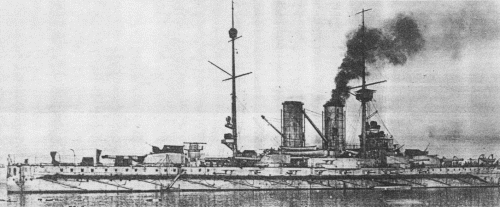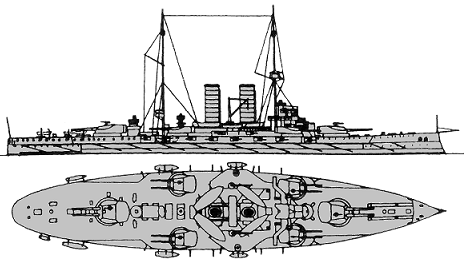
NAVYPEDIA
 Support the project with paypal
Support the project with paypal
Photo

Erzherzog Franz Ferdinand 1917 Many thanks to Wolfgang Stöhr for additional information on this page.
Ships
| Name | No | Yard No | Builder | Laid down | Launched | Comp | Fate |
|---|---|---|---|---|---|---|---|
| Zrínyi | 375 | STT, San Marco | 20.1.1909 | 12.4.1910 | 15.9.1911 | to Italy 1920 | |
| Erzherzog Franz Ferdinand | 376 | STT, San Marco | 12.9.1907 | 30.9.1908 | 5.6.1910 | to Italy 1920 | |
| Radetzky | 377 | STT, San Marco | 26.11.1907 | 3.7.1909 | 15.1.1911 | to Italy 1920 |
Technical data
| Displacement normal, t | 14508 |
|---|---|
| Displacement full, t | 15846 |
| Length, m | 137.5 wl 138.8 oa |
| Breadth, m | 24.6 |
| Draught, m | 8.10 deep load |
| No of shafts | 2 |
| Machinery | 2 4-cyl VTE, 12 Yarrow boilers |
| Power, h. p. | 19800 |
| Max speed, kts | 20.5 |
| Fuel, t | coal 1350 |
| Endurance, nm(kts) | 4000(10) |
| Armour, mm | belt: 230 - 100, main turrets: 250 - 60, secondary turrets: 200 - 50, casemates: 120, deck: 48 with 48mm slopes, torpedo bulkhead: 54, CT: 250 - 100 |
| Armament | 2 x 2 - 305/42 G. L/45 K.10, 4 x 2 - 238/42 G. L/45, 20 x 1 - 100/47 G. L/50 K.10, 2 x 1 - 66/16 G. L/18, 4 x 1 - 47/40 SFK L/44 S, 1 x 1 - 47/30 SFK L/33 H, 3 - 450 TT (2 beam, 1 stern) |
| Complement | 876 |
Standard scale images

Zrínyi 1914
Graphics
Project history
About two weeks after the launching of the Erzherzog Friedrich the Austro-Hungarian Naval Section ordered the start of design work for the next generation of battleships, six weeks after the launching of the Erzherzog Ferdinand Max the Austrian C-in-C, Admiral Montecuccoli, presented his plans for the future build-up of the fleet, envisaging a full strength of 12 battleships, 4 armoured cruisers, 8 scout cruisers, 18 ocean-going destroyers, 36 ocean-going torpedo-boats and 6 submarines. Between 25 and 29 September 1905 a design board evaluated five preliminary designs with similar dimensions and displacements, their armament variants reading dimensions and displacement, their armament variants reading as follows:
A: 4-28cm/45 in centreline twin turrets, 4-24cm/45 in four wing single turrets, 8-19cm/45 in casemates;
B: main and intermediate battery as above, but tertiary battery 12-10cm/45 in casemates;
C: 8-28cm/45 in two centreline and two wing twin turrets, 16-10cm/45 in casemates;
D: 6-30.5cm/45 in two centreline twins and two wing single turrets, 16-10cm/45 in casemates;
E: 4-30.5cm/45 in two centreline twin turrets, 8-19cm/45 in four wing twin turrets, 12-10cm/45 in casemates.
Although the naval architects, headed by Siegfried Popper, and the gunnery technicians voted for the all-big-gun design (pre-project D) the board finally decided in favour of pre-project E. However, even Popper himself stated that a genuine all-big-gun battleship was impracticable as it would require a displacement of at least 16000t, which meant not only increased building costs but also providing a new floating drydock. At a later stage of the design the intermediate calibre was raised from 19cm to 24cm; and 30.5cm was chosen as the main calibre because the wedge breech of the 28cm gun was unreliable. Although the main and intermediate calibre guns were nearly identical from the technical point of view, a comparison of performances shows that the decision was unwise: the 30.5cm gun had nearly double the armour penetration power and a 25% greater range than the 24cm.
Another factor emphasised by Popper was underwater protection. In August and November 1906 explosive trials were held against the hulked centre battery ship Kaiser Max. The tests were held with a 10kg payload but brought no useful results - it had originally been intended to show blast damage on a 1:10 scale representing the standard 100kg mine charge. Bearing in mind these poor results Popper's development of an armoured double bottom anti-mine protection scheme, as it was first incorporated in the Radetzky design, was based entirely on mathematical hypothesis rather than on practical scientific experiment.
As a result of their small displacement the Radetzkys proved to be over-armed and suffered from structural weakness in the hull around the forward CT and magazines resulting in serious deformations. However they were not entirely unsuited for the special circumstances of Adriatic warfare; and again, for the displacement allotted, a very powerful design was achieved. Following the international design practice of the pre-dreadnought period, the choice of an intermediate battery was unusual. The armament was excellent, and the armour not far below that of the British dreadnoughts - but some protection had been sacrificed to speed, it seems, which now approached that of the Regina Elena class.
Ship protection
Main 230mm belt protected the part of hull from some fwd from fwd barbette to some aft from aft barbette extending at 3.6m (including 1.8m above the wl), it was closed by 150mm transverse bulkheads. Ship ends were protected by 100mm belt (fwd part to the stem but aft part ended in 3m from the stern, closed by 100mm bulkhead). Upper belt was 150mm above the 230mm part of the main belt and was closed by 150mm bulkheads. Fwd from the fwd barbette upper belt was 60mm. 10cm casemate was protected by 120mm sides and bulkheads, every gun was isolated by 25mm sides and 15mm rear. Upper casemate had 120mm sides and 100mm bulkheads and was divided on to individual casemates by 25mm bulkheads. Casemates were closed by 24mm decks. Upper deck had 24mm thickness under the casemate and battery deck between casemate and 150mm bulkheads was 28mm. Medium deck between 150mm bulkheads had 36mm flat connected with lower edge of main belt by 48mm slopes. 48mm lower deck outside citadel had turtleback form. There was 54mm longitudinal torpedo bulkhead. Barbettes had 250mm thickness over the upper deck, 240mm between the upper and battery decks (aft part of fwd barbette was 100mm and fwd part of aft barbette was 200mm) and 100mm between battery and medium decks (decreasing to 80mm at rears near the centre line). Secondary barbettes were 200mm (180mm rears) above the upper deck, 100mm (80mm rears) between upper and battery decks and 50mm between battery and medium decks. Main turrets had 250mm faces, sides and rears and 60mm crowns; secondary decks had 200mm faces and sides, 160mm rears and 50mm crowns. Main two-level CT had 250mm (upper level)-240mm(lower level, 200mm at the aft part) sides and 60mm roof, it also had 140-120-100mm large communication tube. Aft CT had 120mm sides at both levels and 40mm roof.
Modernizations
1916-1917, all: + 4 x 1 - 66/47 G. L/50 BAG
Naval service
After Armistice Radetzky and Zrínyi were put under US Navy command and transferred to a berth at Castelli Bay near Spalato (Split) to keep them out of the political quarrel between Italy and Yugoslavia. After the Treaty of St. Germain all three Radetzkys were ceded to Italy; Radetzky and Zrínyi were handed over to the Italians by the US Navy outside the 3-mile zone and were scrapped in Italy in 1920-21; Erzherzog Franz Ferdinand was scrapped in Italy in 1926.
Many thanks to Wolfgang Stöhr for additional information on this page.
 HOME
HOME FIGHTING SHIPS OF THE WORLD
FIGHTING SHIPS OF THE WORLD AUSTRIA-HUNGARY
AUSTRIA-HUNGARY CAPITAL SHIPS
CAPITAL SHIPS ERZHERGOG FRANZ FERDINAND battleships (1910-1911)
ERZHERGOG FRANZ FERDINAND battleships (1910-1911)
